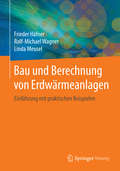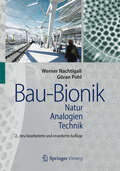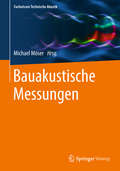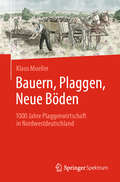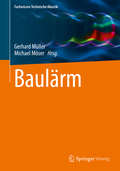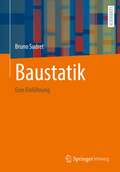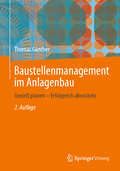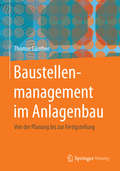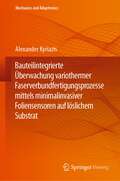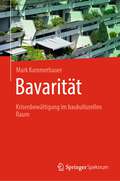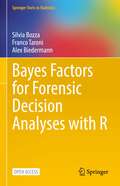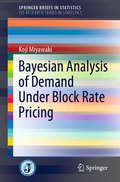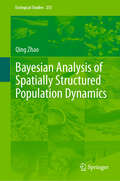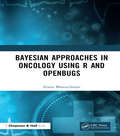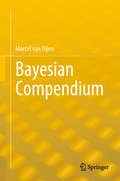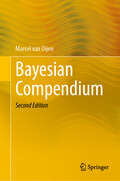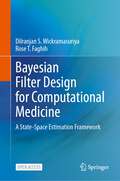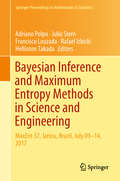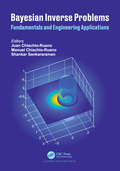- Table View
- List View
Bau und Berechnung von Erdwärmeanlagen: Einführung mit praktischen Beispielen
by Frieder Häfner Rolf-Michael Wagner Linda MeuselDas Buch charakterisiert die Erdw#65533;rmenutzung, beschreibt die #65533;blichen technischen Anlagen dazu, mit Schwerpunkt auf Erdw#65533;rmesonden (EWS) und ihre Einsatzm#65533;glichkeiten. Danach wird die Berechnung von Erdw#65533;rmeanlagen (Einzel-EWS, Sondenfelder) mit mathematisch-analytischen Verfahren und numerischen Simulationsverfahren dargestellt. Die dazu notwendige Software wird Online als Demo-Version bereitgestellt. In einem weiteren Hauptkapitel werden der Bau von Erdw#65533;rmeanlagen, technische Vorausetzungen,Anforderungen und Genehmigungspraxis dargestellt. Der Betrieb der Anlagen und die vielf#65533;ltigen Nutzungsm#65533;glichkeiten f#65533;r Heizen, Warmwasserbereitung, K#65533;hlen ist in den Hauptkapiteln integriert. Beispielhafte Anlagenmuster werden dimensioniert, bautechnisch beschrieben und wirtschaftlich bewertet. Unter den regenerativen Energiequellen f#65533;r die Geb#65533;udeheizung und -klimatisierung nimmt die Erdw#65533;rme (in Form von Erdw#65533;rmesonden etc. mit W#65533;rmepumpen) den ersten Platz ein. Der j#65533;hrliche Zubau von Erdw#65533;rmeanlagen hat steigende Tendenz.
Bau-Bionik: Natur - Analogien - Technik
by Göran Pohl Werner NachtigallBionik befasst sich mit der technischen Umsetzung und Anwendung von Konstruktionen, Verfahren und Entwicklungsprinzipien biologischer Systeme. Beispiele aus der Natur liefern Anregungen zur Entwicklung neuer L#65533;sungen, wie etwa bei thermischen L#65533;ftungssystemen, die sich am Beispiel von Termitenbauten orientieren. Der Band bietet Lesern Gelegenheit, Grundideen der Natur kreativ f#65533;r eigene L#65533;sungen zu nutzen. Daf#65533;r erl#65533;utern die Autoren zahlreiche Beispiele und deren Wirkprinzipien.
Bauakustische Messungen (Fachwissen Technische Akustik)
by Michael MöserDieser Band der Reihe Fachwissen Technische Akustik behandelt die in der Bauakustik meistverbreiteten Messmethoden, vom theoretischen Hintergrund über anwendungspraktische Fragestellungen bis hin zu den nationalen und internationalen Normen. Die Normenreihe der DIN EN ISO 12354 dient dabei als roter Faden, da sie die messbaren Größen der Bauakustik in einen Gesamtzusammenhang bringt. Ausgehend von den Aufgabenstellungen der bauakustischen Messtechnik werden die in Frage kommenden Kenngrößen erläutert. Ein wesentlicher Aspekt ist der Zusammenhang zu den bestehenden nationalen und internationalen Normen. Schwerpunktmäßig werden die Grundprinzipien der Luft- und Trittschalldämmung behandelt. Beschrieben werden Messverfahren, die im Labor und in Gebäuden zum Einsatz kommen. Dabei wird ausführlich auf die Schalldämmung als Bauteil- bzw. Systemeigenschaft eingegangen. Die aus den physikalischen Grundlagen ableitbaren Voraussetzungen der Messverfahren wie z.B. die Anforderungen an die Schallfelder und die daraus ableitbaren Festlegungen der Messverfahren (z.B. Position und Anzahl von Lautsprechern und Mikrofonen) werden eingehend diskutiert. Auf praktische Fragestellungen wie die Notwendigkeit der Fremdgeräuschkorrektur oder den Einfluss der Körperschallnachhallzeiten auf die Messergebnisse wird bei den jeweiligen Messverfahren ebenfalls Bezug genommen. Ein ausführliches Literatur- und Normenverzeichnis ergänzt die behandelten Themen, so dass eine weiterführende Vertiefung ermöglicht wird.
Bauern, Plaggen, Neue Böden: 1000 Jahre Plaggenwirtschaft in Nordwestdeutschland
by Klaus MuellerDie Plaggenwirtschaft war eine über 1000 Jahre praktizierte Form der Landwirtschaft, die den gesamten nordwestdeutschen Raum in einzigartiger Weise geprägt hat. Zeugnisse dieser Landnutzung wie fruchtbare Böden, Eschkanten und ausgedehnte Heidegebiete, lassen sich bis heute in der Landschaft finden. Neben der landwirtschaftlichen Entwicklung, Bodennutzung und typischen Landschaftsformen beeinflusste sie auch ganz wesentlich das Fühlen, Denken, Handeln und Zusammenleben der Menschen dieser Zeit. Aber wer weiß heute noch etwas darüber? Das Buch gibt hierauf spannende und interessante Antworten. Vorgelegt wird eine erste allgemein verständliche Übersicht zu allen Aspekten der Plaggenwirtschaft in Nordwestdeutschland. Angesprochen werden nicht nur Landwirte, Bodenkundler, Geographen und Archäologen, sondern vor allem auch Leser, die Interesse an der bäuerlich geprägten Vergangenheit der Menschen und deren sozio-kulturelle Prägung in Niedersachsen, Nordrhein-Westfalen, Schleswig-Holstein und Teilen Mecklenburgs haben.
Baulärm (Fachwissen Technische Akustik)
by Michael Möser Gerhard MüllerDieser Band der Reihe Fachwissen Technische Akustik handelt hauptsächlich von Baumaschinen und deren Einsatz auf Baustellen. Dabei werden vor Allem die relevanten rechtlichen Rahmenbedingungen im Zusammenhang mit Baulärm in Deutschland dargestellt. Darüber hinaus werden Steuerungsmaßnahmen sowohl aus Deutschland als auch aus anderen Staaten im Vergleich gezeigt. Dieser Beitrag ist an Entwickler von Baumaschinen, Bauplaner, Verwaltungsbehörden, Bauingenieure, Bauherren, durch Baulärm Belästigte und Bauunternehmer gerichtet.
Baustatik: Eine Einführung
by Bruno SudretDieses Lehrbuch bietet eine Einführung in die Strukturmechanik, die sich an Studenten des Bauingenieurwesens und des Maschinenbaus richtet. Er behandelt sowohl statisch bestimmte als auch unbestimmte Strukturen (Balken, Fachwerke, Bögen und Seile) und beinhaltet eine umfassende Darstellung der Kontinuumsmechanik und Elastizitätstheorie, auf der die Balkentheorien von Euler-Bernoulli und Timoshenko rigoros aufgebaut werden können. Ein Schwerpunkt liegt auch auf der Anwendung von Energiesätzen für strukturelle Systeme. Im Unterschied zu den meisten verfügbaren Lehrbüchern, die die Analyse von Strukturen als einen Katalog von Methoden darstellen, die speziell auf die eine oder andere Art von Struktur anwendbar sind, legt dieses Buch den Schwerpunkt auf Methoden der Strukturanalyse, mit einer klaren Verbindung zur Kontinuumsmechanik.
Baustellenmanagement im Anlagenbau: Gezielt planen – Erfolgreich abwickeln
by Thomas GüntherDieses Buch beschreibt umfassend und praxisorientiert die gesamte Prozesskette, von der ersten montagetechnischen Machbarkeitsuntersuchung bis zur Errichtung der Anlage aus Sicht der Bau und Montage. Der Autor vermittelt auf leicht verständlicher Art und Weise die Prinzipien der Angebotsbearbeitung und des Nachunternehmermanagements, die Grundlagen der Bau- und Montagegewerke, das Zusammenspiel der Baustellenplanung und deren Steuerung bis zur Fertigstellung der verfahrenstechnischen Anlagen. Die auf Kennzahlen fokussierte Montageplanung, sowie die vereinfachte Darstellung der Zusammenhänge zwischen Planung und Steuerung machen das Werk zu einem wertvollen Begleiter für Berufseinsteiger und Profis. Erfahrene Projektleiter und Baustellenleiter werden besonders die interkulturelle Herangehensweise an das Thema schätzen.
Baustellenmanagement im Anlagenbau: Von der Planung bis zur Fertigstellung
by Thomas GüntherDieses Buch beschreibt den kompletten Prozess zur Errichtung einer Anlage im internationalen Umfeld. Der Autor vermittelt auf leicht verst#65533;ndlich Art und Weise die Grundlagen f#65533;r Bau und Montage, das Zusammenspiel der Planung und Steuerung bis zur Fertigstellung einer verfahrenstechnischer Anlagen. Die detaillierte Montageplanung sowie die vereinfachte Darstellung der Zusammenh#65533;nge der Planung und Steuerung machen das Werk zu einem wertvollen Begleiter f#65533;r Berufseinsteiger und Fachbauleiter. Baustellenleiter werden besonders die interkulturelle Herangehensweise an das Thema sch#65533;tzen.
Bauteilintegrierte Überwachung variothermer Faserverbundfertigungsprozesse mittels minimalinvasiver Foliensensoren auf löslichem Substrat (Mechanics and Adaptronics)
by Alexander KyriazisUm bei der Fertigung von Faserverbundkunststoffen Zeit, Energie und Kosten sparen zu können, werden möglichst viele Informationen über die Vorgänge während des Fertigungsprozesses benötigt. Die Integration von Foliensensoren in die hergestellten Bauteile ist eine von mehreren Möglichkeiten, diese Informationen zu erhalten. Foliensensoren bestehen aus einer thermoplastischen Folie, auf der metallische Elektroden strukturiert sind. Ihre Integration in das Bauteil bringt unterschiedliche Vor- und Nachteile mit sich. Einerseits sind bauteilintegrierte Sensoren flexibler einsetzbar als werkzeugintegrierte Sensoren und ermöglichen eine feinere räumliche Auflösung der Aushärtevorgänge. Andererseits werden sie bei der Fertigung zum Produktbestandteil. Sie sollten deswegen einfach und kostengünstig sein, sowie die Lasttragfähigkeit nicht beeinträchtigen. Aus mechanischer Sicht bringen Foliensensoren vor allem ein Delaminationsrisiko mit sich. Die Wahl des thermoplastischen Substratmaterials macht dabei den entscheidenden Einflussfaktor aus. Während Sensoren auf Basis des häufig verwendeten Materials Polyimid ein erhebliches Delaminationsrisiko mit sich bringen, ist der Einfluss von Polyetherimid weit weniger schädlich oder verbessert sogar einzelne Festigkeitskennwerte. Neben dem Substratmaterial wirken sich auch die metallischen Sensorstrukturen auf die Belastbarkeit aus. Zur Gestaltung minimalinvasiver Sensoren sollte ein möglichst geringer Metallisierungsgrad angestrebt werden. Das verbreitetste Design für Foliensensoren zur Aushärteüberwachung sind sogenannte Interdigitalelektroden, die eine elektrische Kapazität bilden, deren Impedanz von der direkten Umgebung beeinflusst wird. In variothermen Fertigungsprozessen besteht eine Herausforderung darin, den Einfluss der Temperatur von dem des Aushärtegrades zu trennen. Die an integrierten Sensoren gemessenen Impedanzinformationen müssen dazu eine Verarbeitung durchlaufen, in deren Verlauf die Frequenzabhängigkeit und die Einflüsse von Temperatur und Sensorgeometrie aus den Daten entfernt werden. Für eine variotherme Aushärteüberwachung ist daher die Verwendung eines zusätzlichen Temperatursensors unverzichtbar. Die Sensordaten bieten darüber hinaus Potential für die Ermittlung des Faservolumengehalts oder zur Detektion von Harzfehlanmischungen.
Bauten im Kopf: Architektur und Neurowissenschaften
by Irene Daum Christian HeuchelDieses, zusammen mit dem Architekten Christian Heuchel, verfasste Buch mit dem Titel "Bauen im Kopf - Architektur und Neurowissenschaften erörtert die Bedeutung aktueller Erkenntnisse der Neurowissenschaften und der Psychologie für Perspektiven der Architektur wie Orientierung im Raum, Atmosphäre, sozialer Lebensraum und "intelligente" Gebäude. Des weiteren werden die neuropsychologischen Grundlagen von Planung und Ausführung im Verlauf des Bauprozesses und die Relevanz der künstlichen Intelligenz für die Architektur dargestellt. Zielgruppen sind Architekten und Städteplaner, Studierende der Baukunst, Psychologen und Neurowissenschaftler sowie alle am Thema Baukunst Interessierte. Die Publikation hat zum Ziel, einen Beitrag zu einer eng an menschlichen Bedürfnissen orientierten Architektur zu leisten. Die im Buch diskutierten Anknüpfungspunkte stehen in Zusammenhang mit neuen Studiengängen an Architektur-Fakultäten in den USA und in Italien und gewinnen auch in Deutschland zunehmend an Bedeutung. Der besondere Ansatz des Textes ist die enge Kooperation einer Neuropsychologin und eines Architekten mit langjährigen Erfahrungen auf ihren Gebieten, was eine praxisnahe Diskussion von Zukunftsperspektiven erlaubt.
Bavarität: Krisenbewältigung im baukulturellen Raum
by Mark KammerbauerDas Buch befasst sich mit der Architektur, dem Städtebau und der Stadtplanung im Freistaat Bayern aus interdisziplinärer, urbanistischer Sicht. Damit verbundene baukulturelle Partizipation kann zur Bewältigung von Krisen beitragen, wenn sowohl Akteure der Planung und Gestaltung als auch der Nutzung berücksichtigt werden. Ziel des Buches ist, den gebauten Raum Bayerns zu lesen und zu verstehen, ihn einer Kritik zu unterziehen, dabei die Erfolge nicht auszublenden, um Lösungen zu präsentieren und um schließlich Raum für die Reflexion und das Imaginieren zu "bauen". Wenn Menschen die gebaute Umwelt lesen und verstehen, dann informiert das auch ihr Handeln, insbesondere, wenn sie partizipativ an Planungs- und Gestaltungsprozessen für die Errichtung des gebauten Raums beteiligt sind. Um diese Phänomene ihrem Kontext entsprechend zu fassen und zu deuten, schlägt das Buch den Begriff der Bavarität vor. Im Fall des Freistaats Bayern und seines ländlich-städtischen Kontinuums als Ergebnis historischer baulich-räumlicher Entwicklung, durch Tradition und Moderne konturiert, stellt Bavarität eine sozio-kulturelle Leistung dar, deren Ergebnis in der Partizipation aller Beteiligten gründet und nicht endet.
Bayes Factors for Forensic Decision Analyses with R (Springer Texts in Statistics)
by Silvia Bozza Franco Taroni Alex BiedermannBayes Factors for Forensic Decision Analyses with R provides a self-contained introduction to computational Bayesian statistics using R. With its primary focus on Bayes factors supported by data sets, this book features an operational perspective, practical relevance, and applicability—keeping theoretical and philosophical justifications limited. It offers a balanced approach to three naturally interrelated topics:Probabilistic Inference - Relies on the core concept of Bayesian inferential statistics, to help practicing forensic scientists in the logical and balanced evaluation of the weight of evidence.Decision Making - Features how Bayes factors are interpreted in practical applications to help address questions of decision analysis involving the use of forensic science in the law.Operational Relevance - Combines inference and decision, backed up with practical examples and complete sample code in R, including sensitivity analyses and discussion on how to interpret results in context.Over the past decades, probabilistic methods have established a firm position as a reference approach for the management of uncertainty in virtually all areas of science, including forensic science, with Bayes' theorem providing the fundamental logical tenet for assessing how new information—scientific evidence—ought to be weighed. Central to this approach is the Bayes factor, which clarifies the evidential meaning of new information, by providing a measure of the change in the odds in favor of a proposition of interest, when going from the prior to the posterior distribution. Bayes factors should guide the scientist's thinking about the value of scientific evidence and form the basis of logical and balanced reporting practices, thus representing essential foundations for rational decision making under uncertainty.This book would be relevant to students, practitioners, and applied statisticians interested in inference and decision analyses in the critical field of forensic science. It could be used to support practical courses on Bayesian statistics and decision theory at both undergraduate and graduate levels, and will be of equal interest to forensic scientists and practitioners of Bayesian statistics for driving their evaluations and the use of R for their purposes.This book is Open Access.
Bayesian Analysis of Demand Under Block Rate Pricing (SpringerBriefs in Statistics)
by Koji MiyawakiThis book focuses on the structural analysis of demand under block rate pricing, a type of nonlinear pricing used mainly in public utility services. In this price system, consumers are presented with several unit prices, which makes a naive analysis biased. However, the response to the price schedule is often of interest in economics and plays an important role in policymaking. To address this issue, the book adopts a structural approach, referred to as the discrete/continuous choice approach in the literature, to develop corresponding statistical models for analysis.The resulting models are extensions of the Tobit model, a well-known statistical model in econometrics, and their hierarchical structure fits well in Bayesian methodology. Thus, the book takes the Bayesian approach and develops the Markov chain Monte Carlo method to conduct statistical inferences. The methodology derived is then applied to real-world datasets, microdata collected in Tokyo and the neighboring Chiba Prefecture, as a useful empirical analysis for prediction as well as policymaking.
Bayesian Analysis of Spatially Structured Population Dynamics (Ecological Studies #253)
by Qing ZhaoThe book introduces a series of state-of-art Bayesian models that can be used to understand and predict spatially structured population dynamics in our changing world. Several chapters are devoted to introducing models that utilize detection/non-detection data, count data, combined count and capture-recapture data, and spatial capture-recapture data, respectively. The book provides R code of Metropolis-Hastings algorithms that allow efficient computing of these complex models. The book is aimed at graduate students and researchers who are interested in using and further developing these models.
Bayesian Approaches in Oncology Using R and OpenBUGS
by Atanu BhattacharjeeBayesian Approaches in Oncology Using R and OpenBUGS serves two audiences: those who are familiar with the theory and applications of bayesian approach and wish to learn or enhance their skills in R and OpenBUGS, and those who are enrolled in R and OpenBUGS-based course for bayesian approach implementation. For those who have never used R/OpenBUGS, the book begins with a self-contained introduction to R that lays the foundation for later chapters. Many books on the bayesian approach and the statistical analysis are advanced, and many are theoretical. While most of them do cover the objective, the fact remains that data analysis can not be performed without actually doing it, and this means using dedicated statistical software. There are several software packages, all with their specific objective. Finally, all packages are free to use, are versatile with problem-solving, and are interactive with R and OpenBUGS. This book continues to cover a range of techniques related to oncology that grow in statistical analysis. It intended to make a single source of information on Bayesian statistical methodology for oncology research to cover several dimensions of statistical analysis. The book explains data analysis using real examples and includes all the R and OpenBUGS codes necessary to reproduce the analyses. The idea is to overall extending the Bayesian approach in oncology practice. It presents four sections to the statistical application framework: Bayesian in Clinical Research and Sample Size Calcuation Bayesian in Time-to-Event Data Analysis Bayesian in Longitudinal Data Analysis Bayesian in Diagnostics Test Statistics This book is intended as a first course in bayesian biostatistics for oncology students. An oncologist can find useful guidance for implementing bayesian in research work. It serves as a practical guide and an excellent resource for learning the theory and practice of bayesian methods for the applied statistician, biostatistician, and data scientist.
Bayesian Astrophysics (Canary Islands Winter School of Astrophysics #26)
by Andrés Asensio Ramos Iñigo ArreguiBayesian methods are being increasingly employed in many different areas of research in the physical sciences. In astrophysics, models are used to make predictions to be compared to observations. These observations offer information that is incomplete and uncertain, so the comparison has to be pursued by following a probabilistic approach. <P><P>With contributions from leading experts, this volume covers the foundations of Bayesian inference, a description of computational methods, and recent results from their application to areas such as exoplanet detection and characterisation, image reconstruction, and cosmology. It appeals to both young researchers seeking to learn about Bayesian methods as well as to astronomers wishing to incorporate these approaches in their research areas. It provides the next generation of researchers with the tools of modern data analysis that are already becoming standard in current astrophysical research.<P> Contains beginners' how-to guides and advanced computational tools for Bayesian computation giving direct access into Bayesian computations right from the start.<P> Explains both the fundamentals and state-of-the-art applications in astrophysics, appealing to students and researchers of different levels of experience.<P> Covers a wide range of astrophysical applications as real examples for researchers wishing to implement Bayesian tools in their own areas.
Bayesian Cognitive Modeling
by Michael D. Lee Eric-Jan WagenmakersBayesian inference has become a standard method of analysis in many fields of science. Students and researchers in experimental psychology and cognitive science, however, have failed to take full advantage of the new and exciting possibilities that the Bayesian approach affords. Ideal for teaching and self study, this book demonstrates how to do Bayesian modeling. Short, to-the-point chapters offer examples, exercises, and computer code (using WinBUGS or JAGS, and supported by Matlab and R), with additional support available online. No advance knowledge of statistics is required and, from the very start, readers are encouraged to apply and adjust Bayesian analyses by themselves. The book contains a series of chapters on parameter estimation and model selection, followed by detailed case studies from cognitive science. After working through this book, readers should be able to build their own Bayesian models, apply the models to their own data, and draw their own conclusions.
Bayesian Compendium
by Marcel van OijenThis book describes how Bayesian methods work. Its primary aim is to demystify them, and to show readers: Bayesian thinking isn’t difficult and can be used in virtually every kind of research. In addition to revealing the underlying simplicity of statistical methods, the book explains how to parameterise and compare models while accounting for uncertainties in data, model parameters and model structures. How exactly should data be used in modelling? The literature offers a bewildering variety of techniques and approaches (Bayesian calibration, data assimilation, Kalman filtering, model-data fusion, etc). This book provides a short and easy guide to all of these and more. It was written from a unifying Bayesian perspective, which reveals how the multitude of techniques and approaches are in fact all related to one another. Basic notions from probability theory are introduced. Executable code examples are included to enhance the book’s practical use for scientific modellers, and all code is available online as well.
Bayesian Compendium
by Marcel van OijenThis book describes how Bayesian methods work. Aiming to demystify the approach, it explains how to parameterize and compare models while accounting for uncertainties in data, model parameters and model structures. Bayesian thinking is not difficult and can be used in virtually every kind of research. How exactly should data be used in modelling? The literature offers a bewildering variety of techniques (Bayesian calibration, data assimilation, Kalman filtering, model-data fusion, …). This book provides a short and easy guide to all these approaches and more. Written from a unifying Bayesian perspective, it reveals how these methods are related to one another. Basic notions from probability theory are introduced and executable R codes for modelling, data analysis and visualization are included to enhance the book’s practical use. The codes are also freely available online. This thoroughly revised second edition has separate chapters on risk analysis and decision theory. It also features an expanded text on machine learning with an introduction to natural language processing and calibration of neural networks using various datasets (including the famous iris and MNIST). Literature references have been updated and exercises with solutions have doubled in number.
Bayesian Evolutionary Analysis with BEAST
by Alexei J. Drummond Remco R. BouckaertWhat are the models used in phylogenetic analysis and what exactly is involved in Bayesian evolutionary analysis using Markov chain Monte Carlo (MCMC) methods? How can you choose and apply these models, which parameterisations and priors make sense, and how can you diagnose Bayesian MCMC when things go wrong? These are just a few of the questions answered in this comprehensive overview of Bayesian approaches to phylogenetics. This practical guide: - Addresses the theoretical aspects of the field - Advises on how to prepare and perform phylogenetic analysis - Helps with interpreting analyses and visualisation of phylogenies - Describes the software architecture - Helps developing BEAST 2. 2 extensions to allow these models to be extended further. With an accompanying website providing example files and tutorials (http://beast2. org/), this one-stop reference to applying the latest phylogenetic models in BEAST 2 will provide essential guidance for all users - from those using phylogenetic tools, to computational biologists and Bayesian statisticians.
Bayesian Field Theory
by Jörg C. LemmAsk a traditional mathematician the likely outcome of a coin-toss, and he will reply that no evidence exists on which to base such a prediction. Ask a Bayesian, and he will examine the coin, conclude that it was probably not tampered with, and predict five hundred heads in a thousand tosses; a subsequent experiment would then be used to refine this prediction. The Bayesian approach, in other words, permits the use of prior knowledge when testing a hypothesis.Long the province of mathematicians and statisticians, Bayesian methods are applied in this ground-breaking book to problems in cutting-edge physics. Joerg Lemm offers practical examples of Bayesian analysis for the physicist working in such areas as neural networks, artificial intelligence, and inverse problems in quantum theory. The book also includes nonparametric density estimation problems, including, as special cases, nonparametric regression and pattern recognition. Thought-provoking and sure to be controversial, Bayesian Field Theory will be of interest to physicists as well as to other specialists in the rapidly growing number of fields that make use of Bayesian methods.
Bayesian Filter Design for Computational Medicine: A State-Space Estimation Framework
by Dilranjan S. Wickramasuriya Rose T. FaghihThis book serves as a tutorial that explains how different state estimators (Bayesian filters) can be built when all or part of the observations are binary. The book begins by briefly motivating the need for point process state estimation followed by an introduction to the overall approach, as well as some basic background material in statistics that are necessary for the equation derivations that are utilized in subsequent chapters. The subsequent chapters focus on different state-space models and provide step-by-step explanations on how to build the corresponding Bayesian filters. Each of the main chapters that describes a single state-space model also describes the corresponding MATLAB code examples at the end. Descriptions are also provided regarding the code. The code contains both simulated and experimental data examples. All the experimental data examples are taken from real-world experiments. The experiments involve the recording of skin conductance, heartrate and blood cortisol data. A MATLAB toolbox of code examples that cover the different filters covered in the book is included in a companion webpage. The book is primarily intended for graduate students in either electrical engineering or biomedical engineering who will be beginning research in state estimation related to point process data or mixed data (i.e., point processes and other types of observations). The book can also be used by practicing researchers who measure skin conductance and heart rate or pulsatile hormones in their own work (e.g. in psychology). This is an open access book.
Bayesian Filtering and Smoothing
by Simo SärkkäFiltering and smoothing methods are used to produce an accurate estimate of the state of a time-varying system based on multiple observational inputs (data). Interest in these methods has exploded in recent years, with numerous applications emerging in fields such as navigation, aerospace engineering, telecommunications and medicine. This compact, informal introduction for graduate students and advanced undergraduates presents the current state-of-the-art filtering and smoothing methods in a unified Bayesian framework. Readers learn what non-linear Kalman filters and particle filters are, how they are related, and their relative advantages and disadvantages. They also discover how state-of-the-art Bayesian parameter estimation methods can be combined with state-of-the-art filtering and smoothing algorithms. The book's practical and algorithmic approach assumes only modest mathematical prerequisites. Examples include MATLAB computations, and the numerous end-of-chapter exercises include computational assignments. MATLAB/GNU Octave source code is available for download at www.cambridge.org/sarkka, promoting hands-on work with the methods.
Bayesian Inference and Maximum Entropy Methods in Science and Engineering: MaxEnt 37, Jarinu, Brazil, July 09–14, 2017 (Springer Proceedings in Mathematics & Statistics #239)
by Adriano Polpo Francisco Louzada Julio Stern Rafael Izbicki Hellinton TakadaThese proceedings from the 37th International Workshop on Bayesian Inference and Maximum Entropy Methods in Science and Engineering (MaxEnt 2017), held in São Carlos, Brazil, aim to expand the available research on Bayesian methods and promote their application in the scientific community. They gather research from scholars in many different fields who use inductive statistics methods and focus on the foundations of the Bayesian paradigm, their comparison to objectivistic or frequentist statistics counterparts, and their appropriate applications. Interest in the foundations of inductive statistics has been growing with the increasing availability of Bayesian methodological alternatives, and scientists now face much more difficult choices in finding the optimal methods to apply to their problems. By carefully examining and discussing the relevant foundations, the scientific community can avoid applying Bayesian methods on a merely ad hoc basis. For over 35 years, the MaxEnt workshops have explored the use of Bayesian and Maximum Entropy methods in scientific and engineering application contexts. The workshops welcome contributions on all aspects of probabilistic inference, including novel techniques and applications, and work that sheds new light on the foundations of inference. Areas of application in these workshops include astronomy and astrophysics, chemistry, communications theory, cosmology, climate studies, earth science, fluid mechanics, genetics, geophysics, machine learning, materials science, medical imaging, nanoscience, source separation, thermodynamics (equilibrium and non-equilibrium), particle physics, plasma physics, quantum mechanics, robotics, and the social sciences. Bayesian computational techniques such as Markov chain Monte Carlo sampling are also regular topics, as are approximate inferential methods. Foundational issues involving probability theory and information theory, as well as novel applications of inference to illuminate the foundations of physical theories, are also of keen interest.
Bayesian Inverse Problems: Fundamentals and Engineering Applications
by Juan Chiachío-RuanoThis book is devoted to a special class of engineering problems called Bayesian inverse problems. These problems comprise not only the probabilistic Bayesian formulation of engineering problems, but also the associated stochastic simulation methods needed to solve them. Through this book, the reader will learn how this class of methods can be useful to rigorously address a range of engineering problems where empirical data and fundamental knowledge come into play. The book is written for a non-expert audience and it is contributed to by many of the most renowned academic experts in this field.
